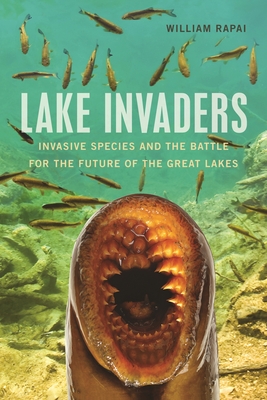Lake Invaders: Invasive Species and the Battle for the Future of the Great Lakes

Lake Invaders: Invasive Species and the Battle for the Future of the Great Lakes
There are more than 180 exotic species in the Great Lakes. Some, such as green algae, the Asian tapeworm, and the suckermouth minnow, have had little or no impact so far. But a handful of others-sea lamprey, alewife, round goby, quagga mussel, zebra mussel, Eurasian watermilfoil, spiny water flea, and rusty crayfish-have conducted an all-out assault on the Great Lakes and are winning the battle. In Lake Invaders: Invasive Species and the Battle for the Future of the Great Lakes, William Rapai focuses on the impact of these invasives. Chapters delve into the ecological and economic damage that has occurred and is still occurring and explore educational efforts and policies designed to prevent new introductions into the Great Lakes.
Rapai begins with a brief biological and geological history of the Great Lakes. He then examines the history of the Great Lakes from a human dimension, with the construction of the Erie Canal and Welland Canal, opening the doors to an ecosystem that had previously been isolated. The seven chapters that follow each feature a different invasive species, with information about its arrival and impact, including a larger story of ballast water, control efforts, and a forward-thinking shift to prevention. Rapai includes the perspectives of the many scientists, activists, politicians, commercial fishermen, educators, and boaters he interviewed in the course of his research. The final chapter focuses on the stories of the largely unnoticed and unrecognized advocates who have committed themselves to slowing, stopping, and reversing the invasion and keeping the lakes resilient enough to absorb the inevitable attacks to come. Rapai makes a strong case for what is at stake with the growing number of invasive species in the lakes. He examines new policies and the tradeoffs that must be weighed, and ends with an inspired call for action. Although this volume tackles complex ecological, economical, and political issues, it does so in a balanced, lively, and very accessible way. Those interested in the history and future of the Great Lakes region, invasive species, environmental policy making, and ecology will enjoy this informative and thought-provoking volume.216.92Lei
216.92Lei
Livrare in 2-4 saptamani
Descrierea produsului
There are more than 180 exotic species in the Great Lakes. Some, such as green algae, the Asian tapeworm, and the suckermouth minnow, have had little or no impact so far. But a handful of others-sea lamprey, alewife, round goby, quagga mussel, zebra mussel, Eurasian watermilfoil, spiny water flea, and rusty crayfish-have conducted an all-out assault on the Great Lakes and are winning the battle. In Lake Invaders: Invasive Species and the Battle for the Future of the Great Lakes, William Rapai focuses on the impact of these invasives. Chapters delve into the ecological and economic damage that has occurred and is still occurring and explore educational efforts and policies designed to prevent new introductions into the Great Lakes.
Rapai begins with a brief biological and geological history of the Great Lakes. He then examines the history of the Great Lakes from a human dimension, with the construction of the Erie Canal and Welland Canal, opening the doors to an ecosystem that had previously been isolated. The seven chapters that follow each feature a different invasive species, with information about its arrival and impact, including a larger story of ballast water, control efforts, and a forward-thinking shift to prevention. Rapai includes the perspectives of the many scientists, activists, politicians, commercial fishermen, educators, and boaters he interviewed in the course of his research. The final chapter focuses on the stories of the largely unnoticed and unrecognized advocates who have committed themselves to slowing, stopping, and reversing the invasion and keeping the lakes resilient enough to absorb the inevitable attacks to come. Rapai makes a strong case for what is at stake with the growing number of invasive species in the lakes. He examines new policies and the tradeoffs that must be weighed, and ends with an inspired call for action. Although this volume tackles complex ecological, economical, and political issues, it does so in a balanced, lively, and very accessible way. Those interested in the history and future of the Great Lakes region, invasive species, environmental policy making, and ecology will enjoy this informative and thought-provoking volume.Detaliile produsului










